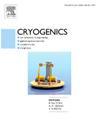Effect of spark plasma sintering on the superconducting properties of Sm-based oxypnictide
IF 2.1
3区 工程技术
Q3 PHYSICS, APPLIED
引用次数: 0
Abstract
We optimize the superconducting properties of Sm-based oxypnictide (Sm1111: SmFeAsO0.80F0.20) by using the Spark Plasma Sintering (SPS) technique under various synthesis conditions, including heating temperatures ranging from 600 to 1000 °C for durations of 5 to 30 min at the applied pressure of 45 MPa. All prepared bulks are characterized by structural and microstructural analysis as well as transport and magnetic measurements to conclude our findings. SmFeAsO0.80F0.20 bulks are also prepared using the conventional synthesis process at ambient pressure (CSP) and the high gas pressure and high temperature (HP-HTS) methods at 500 MPa, which exhibit a superconducting transition temperature (Tc) of 53–54 K. Interestingly, the SPS process of SmFeAsO0.80F0.20 increases the sample densities up to 97–98 % and confirms the optimized synthesis conditions of 900 °C for 5–10 min; however, the increased sintering temperature or duration reduces Tc due to the possible evaporation of lighter elements, particularly fluorine. Furthermore, the SPS technique is unable to reduce the observed impurity phases for the Sm1111, which is similar to the CSP and HP-HTS processes. A slight increment in the Jc by the SPS process is observed due to the enhancement of sample density. A comparative analysis of Sm1111 superconductors prepared by SPS is performed with CSP and HP-HTS processes, suggesting that an increased sample density is ineffective on the superconducting properties in the presence of the impurity phases. This finding can be beneficial for the fundamental and applied research of iron-based superconductor (FBS).
火花等离子烧结对sm基氧nictide超导性能的影响
我们利用火花等离子烧结(SPS)技术在不同的合成条件下优化了sm基氧nictide (Sm1111: SmFeAsO0.80F0.20)的超导性能,包括在45 MPa的压力下,加热温度从600到1000℃,持续时间为5到30分钟。通过结构和微观结构分析以及输运和磁性测量来确定所有制备体的特征,以总结我们的发现。采用常规的常压(CSP)和高压高温(HP-HTS)方法在500 MPa下制备了SmFeAsO0.80F0.20块体,其超导转变温度(Tc)为53 ~ 54 K。有趣的是,SmFeAsO0.80F0.20的SPS工艺使样品密度提高了97 - 98%,并证实了900°C 5-10 min的最佳合成条件;然而,由于可能蒸发较轻的元素,特别是氟,烧结温度或持续时间的增加会降低Tc。此外,SPS技术无法减少Sm1111中观察到的杂质相,这与CSP和HP-HTS工艺相似。由于样品密度的增加,SPS过程中观察到Jc的轻微增加。将SPS制备的Sm1111超导体与CSP和HP-HTS工艺进行了对比分析,结果表明,在杂质相存在的情况下,增加样品密度对超导性能没有影响。这一发现对铁基超导体(FBS)的基础和应用研究具有重要意义。
本文章由计算机程序翻译,如有差异,请以英文原文为准。
求助全文
约1分钟内获得全文
求助全文
来源期刊

Cryogenics
物理-热力学
CiteScore
3.80
自引率
9.50%
发文量
0
审稿时长
2.1 months
期刊介绍:
Cryogenics is the world''s leading journal focusing on all aspects of cryoengineering and cryogenics. Papers published in Cryogenics cover a wide variety of subjects in low temperature engineering and research. Among the areas covered are:
- Applications of superconductivity: magnets, electronics, devices
- Superconductors and their properties
- Properties of materials: metals, alloys, composites, polymers, insulations
- New applications of cryogenic technology to processes, devices, machinery
- Refrigeration and liquefaction technology
- Thermodynamics
- Fluid properties and fluid mechanics
- Heat transfer
- Thermometry and measurement science
- Cryogenics in medicine
- Cryoelectronics
 求助内容:
求助内容: 应助结果提醒方式:
应助结果提醒方式:


